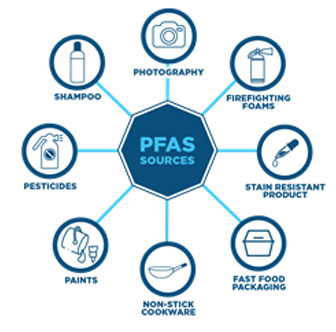 What are PFAS?
What are PFAS?
Per- and polyfluoroalkyl substances (PFAS) are a group of man-made chemicals that includes PFOA, PFOS, GenX, and many other chemicals. PFAS have been manufactured and used in a variety of industries around the globe, including in the United States since the 1940s. PFOA and PFOS have been the most extensively produced and studied of these chemicals. Both chemicals are very persistent in the environment and in the human body – meaning they don’t break down and they can accumulate over time. There is evidence that exposure to PFAS can lead to adverse human health effects.
Uses
Different classes of PFAS are used in the manufacturing of a variety of products. Beyond well-known applications like fire-fighting foams, carpet protectant and non-stick cookware, PFAS are used in important products such as surgical gowns and drapes, where these materials help prevent infections. They are also critical to the manufacturing of electronic devices such as cell phones and semi-conductors. Commercial aircraft and low-emissions vehicles also rely on PFAS technology.
Sources & Potential Exposure
PFAS can be found in:
- Food packaged in PFAS-containing materials, processed with equipment that used PFAS, or grown in PFAS-contaminated soil or water.
- Commercial household products, including stain- and water-repellent fabrics, nonstick products (e.g., Teflon), polishes, waxes, paints, cleaning products, and fire-fighting foams (a major source of groundwater contamination at airports and military bases where firefighting training occurs ).
- Workplace, including production facilities or industries (e.g., chrome plating, electronics manufacturing or oil recovery) that use PFAS.
- Drinking water, typically localized and associated with a specific facility (e.g., manufacturer, landfill, wastewater treatment plant, firefighter training facility).
- Living organisms, including fish, animals and humans, where PFAS have the ability to build up and persist over time.
Individuals can be exposed to PFAS through contaminated soil used to grow food, food packaging products, and via equipment used PFAS during food processing. People can also be exposed to PFAS chemicals if they are released during normal use, biodegradation, or disposal of consumer products that contain PFAS. People may be exposed to PFAS used in commercially-treated products to make them stain- and water-repellent or nonstick. These goods include carpets, leather and apparel, textiles, paper and packaging materials, and non-stick cookware.
People who work at PFAS production facilities, or facilities that manufacture goods made with PFAS, may be exposed in certain occupational settings or through contaminated air.
Drinking water can be a source of exposure in communities where these chemicals have contaminated water supplies. Such contamination is typically localized and associated with a specific facility, for example, an industrial facility where PFAS were produced or used to manufacture other products, or an oil refinery, airfield or other location at which PFAS were used for firefighting.
There is evidence that exposure to PFAS can lead to adverse health outcomes in humans. If humans, or animals, ingest PFAS (by eating or drinking food or water than contain PFAS), the PFAS are absorbed, and can accumulate in the body. PFAS stay in the human body for long periods of time. As a result, as people get exposed to PFAS from different sources over time, the level of PFAS in their bodies may increase to the point where they suffer from adverse health effects.
Studies indicate that PFOA and PFOS can cause reproductive and developmental, liver and kidney, and immunological effects in laboratory animals. Both chemicals have caused tumors in animal studies. The most consistent findings from human epidemiology studies are increased cholesterol levels among exposed populations, with more limited findings related to:
- Infant birth weights,
- Effects on the immune system,
- Cancer (for PFOA)
- Thyroid hormone disruption (for PFOS).
Federal Regulations
The EPA has provided provisional Peer Reviewed Toxicity Values for PFBS for use in site decision making, identified the universe of PFAS currently being manufactured and used, collected scientific literature on PFAS toxicity, developed draft human health toxicity values for GenX and PFBS, providing states with access to test data obtained under TSCA authority for GenX chemicals (acid and salt), and provide access to PFAS related publications, data and information with regards to the human health impacts of PFAS .

 Americas
Americas Europe
Europe Français
Français Deutsch
Deutsch Italiano
Italiano Español
Español


